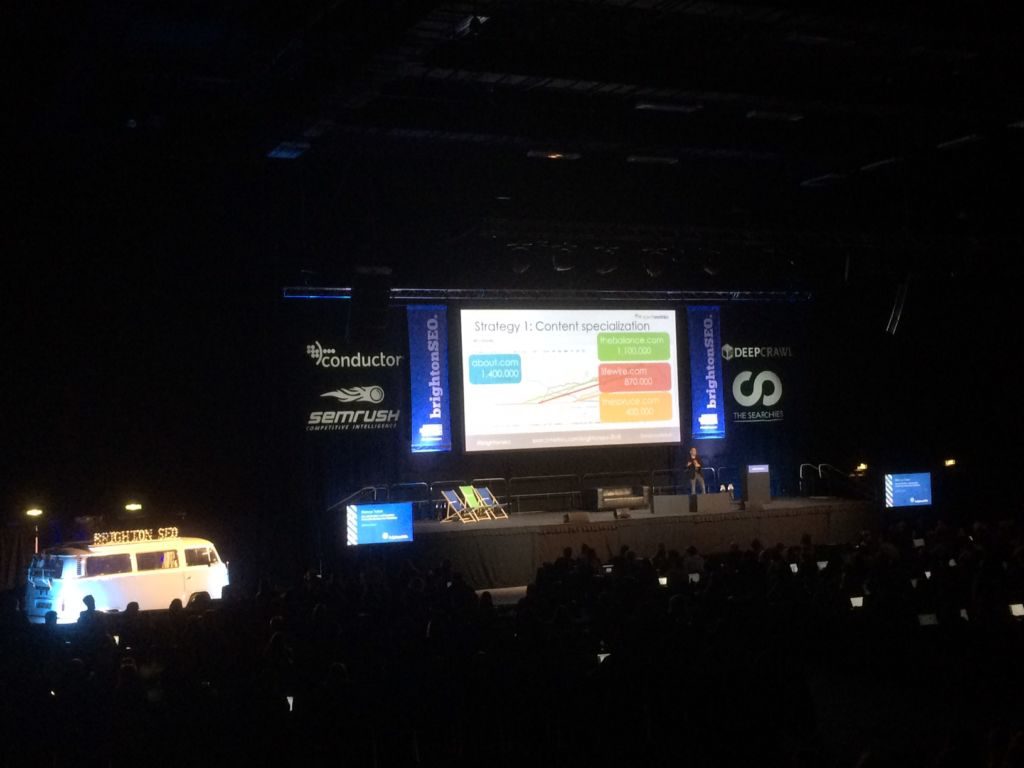Topical themes at the BrightonSEO conference (April 2018) included the continued rise of voice search, mobile search and perspective on the role of content. One key lesson that’s by no means new – but is certainly often overlooked by many brands – is that ‘less is more’ in content marketing.
To give our content the best chance of ranking highly on search engines, we need to look at the data. The sad fact is that brands have been pumping ‘content’ onto the Web, little of which has made an impression.
When done well, business blogging brings business benefits, but the corporate blog output has increased by more than 800% in the last five years, while social shares have decreased by 89%. As Steve Rayson of BuzzSumo highlighted at BrightonSEO, the vast majority of content (90%) gets less than 62 engagements, while just 5% gets more than 343 shares.

Searchmetrics’ Marcus Tober addresses BrightonSEO (April 2018)
To recap, when deciding what to rank where on its results pages, Google loves:
- Fast page loads
- Inbound links from diverse and authoritative sites
- Good dwell time metrics
- Structured content
Getting backlinks even harder than ever. According to BuzzSumo’s data, 70% of the 100 million articles the company studied had 0 backlinks.
Top tips to rank high on Google
Classic PR 101: I’ve presented the problem, now we need a solution. How can we increase the chances of our content ranking highly on Google and provide us with valuable, engaged visitors?
Marcus Tober of Searchmetrics’ advice was three-fold. In order to compete for rank, we need to:
Specialise: We can’t offer everything on one single page and we can’t be relevant for everything. Tober cited the example of how About.com built brands for different specialisms to serve the user intent. We should use text, images or video content according to user need.
Update content: To enable Google’s search bots to crawl effectively, we need to use longer text, it needs to be structured and up-to-date. On the structure front, the rise of snippets has certainly helped the growth in lists. If I look at the data from my own (non-work-related) blog, Outside Write, for the last 12 months I note that – of the top ten performing pages where the traffic was driven by Google – five are lists, four are answers to common queries and the other is my homepage.
Remove some content: When you have content that’s too similar, Google’s bots don’t know what to prioritise. Eleni Cashell said that 29% of content is duplicate. It’s hard to delete content but Google can crawl faster and understands value of the content easier. Page speed is also a key ranking factor as Google is focused on the user experience, so if you have clunky content that’s not converting, it could be time to free up some space and kill it off.
Long-form content works
The average word count of written content is rising, averaging 1,900 words in 2017 – up from 1,300 in 2015. This is important to note as SEO is making a comeback. Facebook had overtaken Google for referrals to news between 2012-15, but in the last year Facebook referrals – and social shares in general – have fallen, and Google now sends twice as much traffic to publishers than Facebook, according to BuzzSumo’s Rayson.
But we still need to create content that earns links in an era of content saturation, and that’s why less is more. Fewer, long-form posts – such as research or tips that answer a specific question – are going to stand a better chance of ranking, according to Rayson. His advice is to get on a topic early or corner a niche, echoing Tober’s advice to specialise.
To conclude, I second Eleni Cashell’s recommendation of auditing content thoroughly, updating what’s out of date, deleting what’s no longer relevant, using canonicals to signpost priority content to Google’s search bots, and really making sure all future content is unique.
If you want to improve your content marketing, please get in touch to see how we could help.
